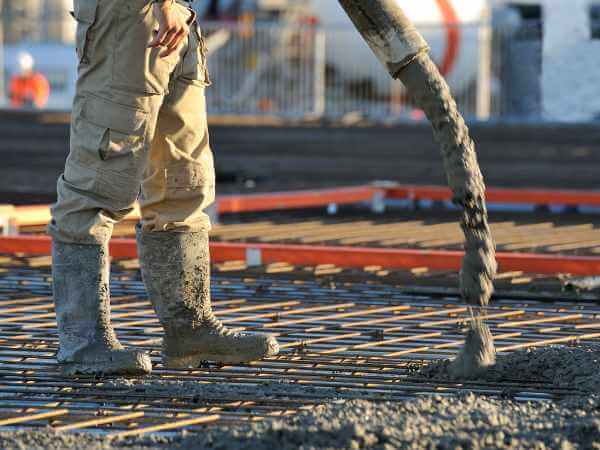This blog post might contain affiliate links – read our full affiliate disclosure here.
As some construction professionals are aware: “Concrete curing is an art”. Achieving optimal curing temperature is difficult in challenging weather conditions, such as colder seasons. Within this context, heated concrete blankets arise as an alternative, but are they really effective?
Yes, heated concrete blankets are an excellent alternative to ensure proper curing and hardening when outdoor temperatures drop below 50°F (10°C). They can also be very helpful to speed up the concrete drying and hardening process, allowing, for example, paved areas to be open for traffic sooner.
In this article, we will explore the effectiveness of heated concrete blankets, how they work, when to use them, their pros and cons, available options, and potential alternatives.
How Does a Heated Concrete Blanket Work?
Heated concrete blankets use advanced heating technology to enable curing and allow temperatures to stay inside the desired range, especially during cold weather conditions.
These blankets are typically made of durable, insulated materials that efficiently and evenly distribute heat across the concrete surface.
The heating elements embedded within the cover generate and maintain a consistent temperature conducive to optimal curing and preventing excessive temperature drops that might hinder concrete hardening and lead to excessive cracking.
When to Use a Heated Concrete Blanket?
Overall, heated concrete blankets are mostly used in winter, when temperatures can drop below 50°F (10°C), which can significantly impact on curing and lead to undesired pathologies, such as cracking.
According to the Guide to Cold Weather Concreting (ACI 306R-16), developed by the American Concrete Institute, cold weather conditions are defined as “...when the air temperature has fallen to, or is expected to fall below, 40°F (4.5°C) during the protection period.”
This report from the NJDOT (New Jersey Department of Transport) recommends that concrete placement should not proceed when temperatures are less than 50°F (10°C) unless heated water is used for the mix and heating blankets are used for the curing.
These warming covers are also vastly used when time restrictions are in place and quick drying is necessary (i.e. when structural elements require early loadings, such as concrete pavement or sidewalks.)

What are the Pros and Cons of Using a Heated Concrete Blanket?
Like any construction tool or method, the use of heated concrete blankets comes with its advantages and disadvantages. The table below summarises some of them.
|
Pros |
Cons |
|
|
Concrete Heated Blanket - Options
Different brands offer blankets with varying sizes, heating capacities, and features. Some blankets are adjustable, allowing contractors to set specific temperatures, while others come with built-in sensors for temperature monitoring.
Our recommendation is Power Blanket, which has been widely used by concrete experts and comes with a thermostatic controller that facilitates temperature control.
It’s important to choose a blanket that suits your project needs and consider factors such as surface area, weather conditions, and specific curing requirements.
What is an Alternative to a Heated Concrete Blanket?
While heated concrete blankets are highly effective, alternative methods can be considered based on your constraints, budget, and preferences. Some options are:
- Polyethylene (PE) Curing Blankets
- Woven Polypropylene (PP) Curing Blankets
- Composite Curing Blankets
- Insulating Concrete Curing Blankets
- Reusable Curing Blankets
We recommend the following article for more details in relation to alternatives: What is a Concrete Curing Blanket? (And When/Why to Use them?)
FAQ
How long should a heated concrete blanket be left on fresh poured concrete in cold weather?
It is recommended to leave a heated concrete blanket on freshly poured concrete for a minimum of 24 to 48 hours if the structure is not expected to bear loading in the early days.
The exact time will vary according to loading requirements and environmental conditions, and you should refer to the protecting period requirements detailed in the ACI 306-R16 for further details and consult with a structural engineer
Do Heated Concrete Blankets Leave Marks?
Unfortunately, both heated and common concrete blankets might lead to surface marks or discolouration if not used properly.
This might be caused by wrinkles and folds in the blankets, which can lead to discontinuous curing conditions.
What temperature is too cold for concrete pouring?
Generally, concrete pouring should be avoided when the ambient temperature falls below 50°F (10°C). At temperatures below this threshold, the concrete may not cure properly and could be susceptible to freezing or other quality issues.
For specific details, please consult with a structural engineer and ensure compliance with the relevant norms (i.e. ACI 306-R16 by American Concrete Institute)
Conclusion
Heated concrete blankets are an effective solution for ensuring proper concrete curing and hardening, particularly in challenging weather conditions, especially when temperatures drop below 50°F (10°C).
It’s important to consider the pros and cons before using these coverings. On the positive side, heated concrete blankets can enhance early concrete strength and optimal curing. However, they might be costly to implement and lead to pathologies if not properly used and operated.
Our recommendation is Power Blanket, known for its thermostatic controller. There are other alternatives if you are pouring in mild weather conditions (above 50°F), such as polypropylene curing blankets and other options detailed in this article (click here).













